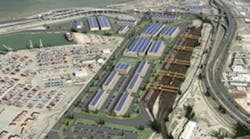A combination of factors will come together in 2018 that will result in strong investor appetite for logistics real estate, according to CBRE. The demand, from e-commerce growth to last-mile logistics, combined with an abundance of institutional capital in the global market, are the forces behind the increase this year.
And the growth is not just in the U.S.—it's global. Strong interest in prime logistics assets continues in most industrial hubs around the world, with $85.8 billion in total investment volume in the first three quarters of 2017, an increase of 12% year-over-year, according to the report.
Regional Trends
Overall, the prime logistics sector is performing well in the Americas, EMEA and Asia Pacific, supporting a healthy capital investment environment with steady yield compression in most industrial hubs. The logistics sector continues to be impacted by structural changes, such as online retailing, that have transformed global supply chains.
E-commerce operators require an estimated average of up to three times more space than traditional warehouse users due to a greater diversity in products handled and the need to have them immediately accessible. This has piqued the interest of global investors who continue to add industrial assets to their portfolios at lower cap rates, with the reasonable expectation that they will achieve immediate rent growth.
There is a growing trend of cross-border investment into industrial real estate, especially from Asia. Despite Chinese government restrictions on overseas investments as of late 2016, Chinese investors have acquired more than $773 million in U.S. industrial real estate to date this year—equating to 89% of their U.S. investment total for all 2016.
Asian capital has also been targeting Europe. In June 2017, sovereign wealth fund China Investment Corp. agreed to purchase Logicor, a pan-European logistics company, from Blackstone for $12.25 billion. The 147 million-sq.-ft. portfolio of high-quality logistics assets spans 17 countries, with 70% of it concentrated in the U.K., Germany, France and Southern Europe.
“Industrial demand and strong property fundamentals, particularly in this cycle, have piqued the interest of global investors, especially from China," says Jack Fraker, managing director, Global Industrial & Logistics, CBRE. "Domestic wealth has grown significantly in China in recent years, and investors are seeking to diversify their portfolios with global acquisitions in the U.S. and Europe. Competition for prime industrial properties is strong, and the volume of capital that is under-allocated in the industrial asset class has become increasingly aggressive."
Fraker adds, "Prime logistics is an attractive asset class for investors that provides a high return and stable cash flow due to the strong user fundamentals, which is largely fueled by e-commerce growth and demand for last-mile logistics. Given the amount of institutional capital in the global market, and the robust appetite for logistics real estate, strong investment activity should continue in 2018 with some markets experiencing further yield compression."
EMEA had the largest decline in yields year-over-year. Prime yields decreased by an average of 35 basis points (bps) over the 12-month period (Q3 2016 – Q3 2017), with most European markets seeing a decline. Yields tightened the most in Paris/Lyon (-75 bps to 5.00%) and Munich (-60 bps to 4.50%).
Nearly half of the Americas markets experienced yield compression year-over-year. The U.S. industrial market continues to experience tightening fundamentals, with limited new supply and rising rents, driving capital flight to high-performing markets such as Seattle, Oakland, Los Angeles/Orange County, New Jersey and Inland Empire, each of which recorded cap rates of between 4.00 and 4.25%.
Increased turnover and yield compression is driven by demand for logistics facilities in APAC. Investment turnover in the sector increased 51% year-over-year in Q3 2017, while yields tightened by 29 bps year-over-year to 6.68%. Demand from e-commerce has been strong in China, South Korea and India, with many investors taking advantage of this structural change in consumer behavior.



